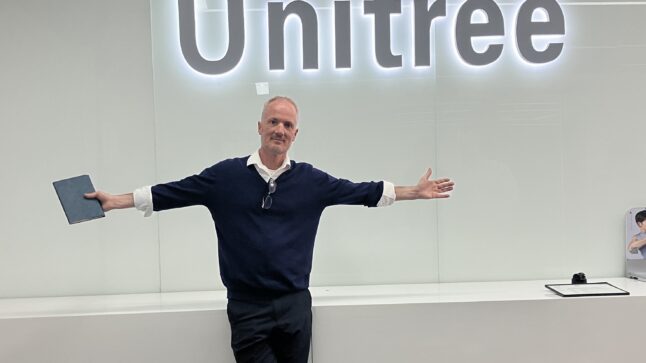This week’s podcast is about my visits to Xiaomi and Horizon Robotics.
You can listen to this podcast here, which has the slides and graphics mentioned. Also available at iTunes and Google Podcasts.
Here is the link to the TechMoat Consulting.
Here is the link to our Tech Tours.
Lessons from Xiaomi
- Consumption ecosystem. Car, person, home
- High performance management
- Rapid manufacturing build out as a capability. Cheap. But also fast and flexible. Upgrades. Increasing combined with software and AI
Lessons from Unitree
- Big jump in agility.
- Limited use cases for them today.
- Programmed in simulation and downloaded. Sim to Lab. ML at edge, vs download vs connectivity
Here are some photos from Xiaomi:
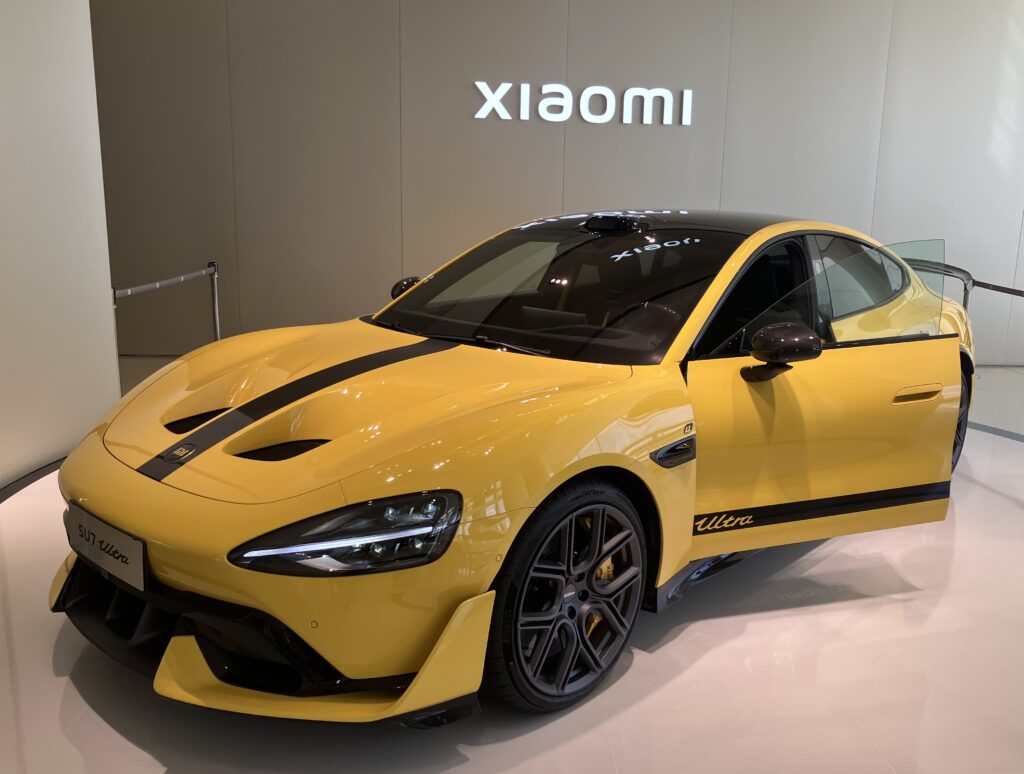
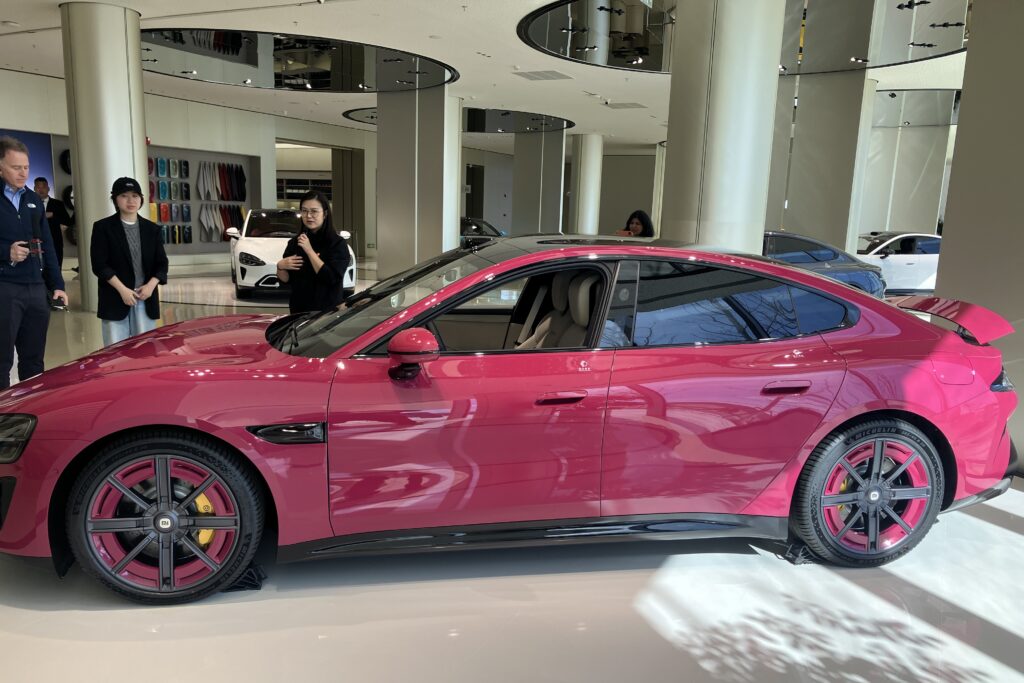
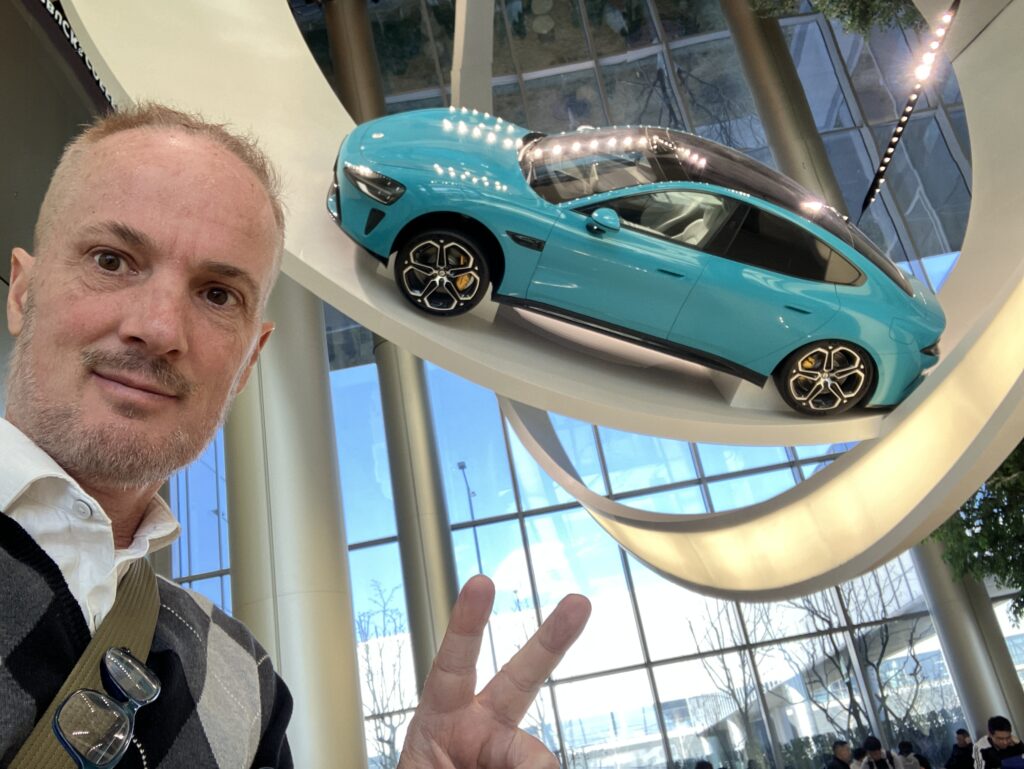
Here are some photos from Unitree Robotics:
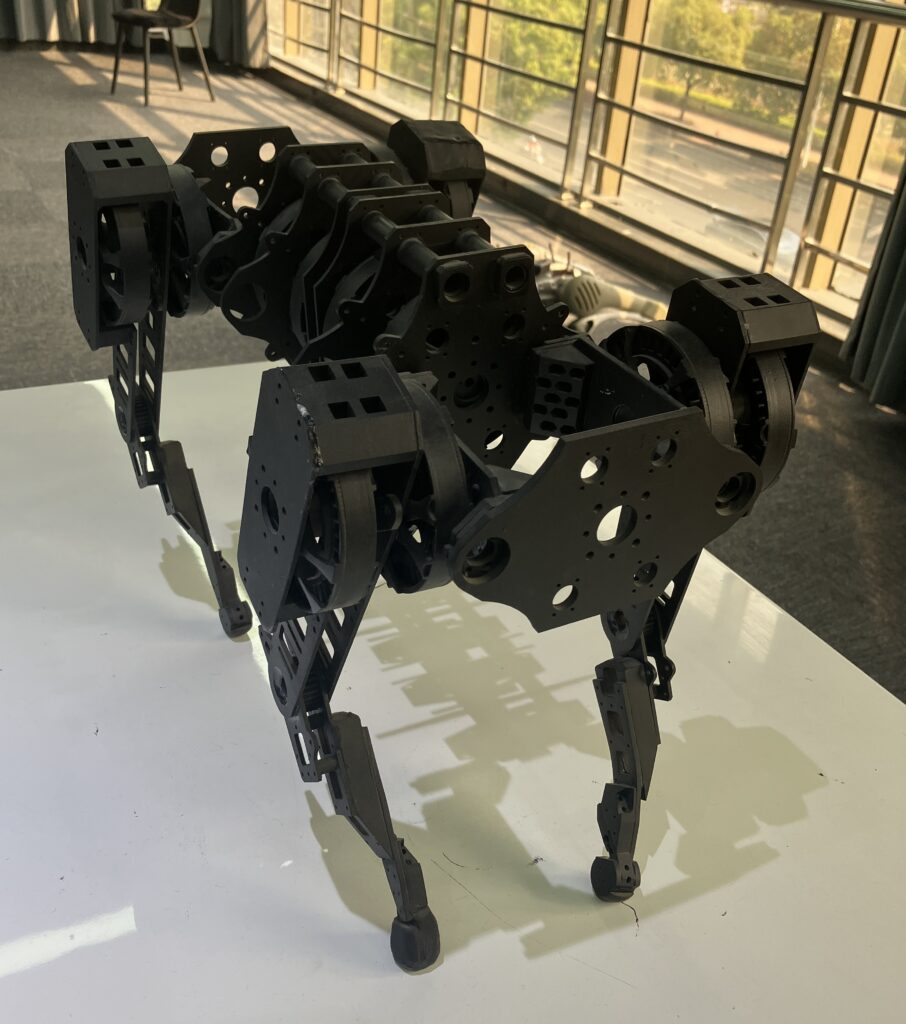
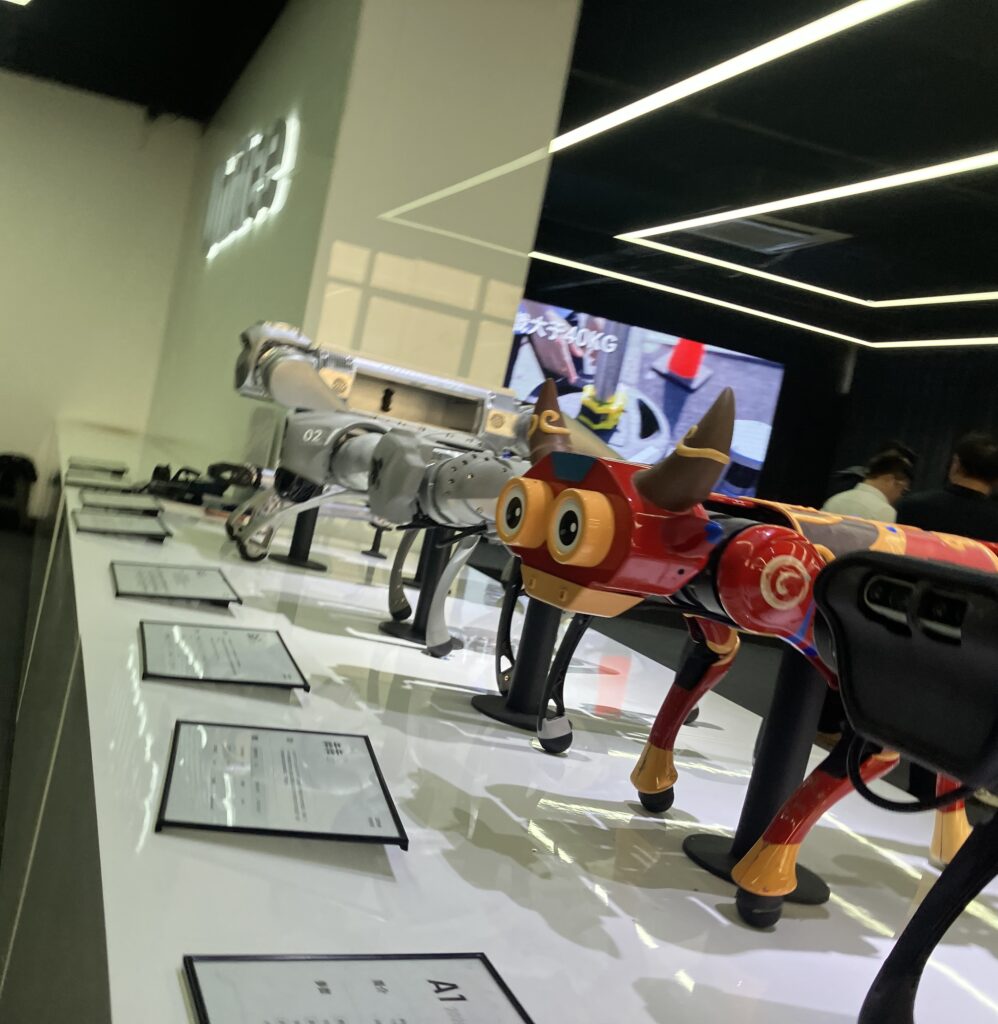
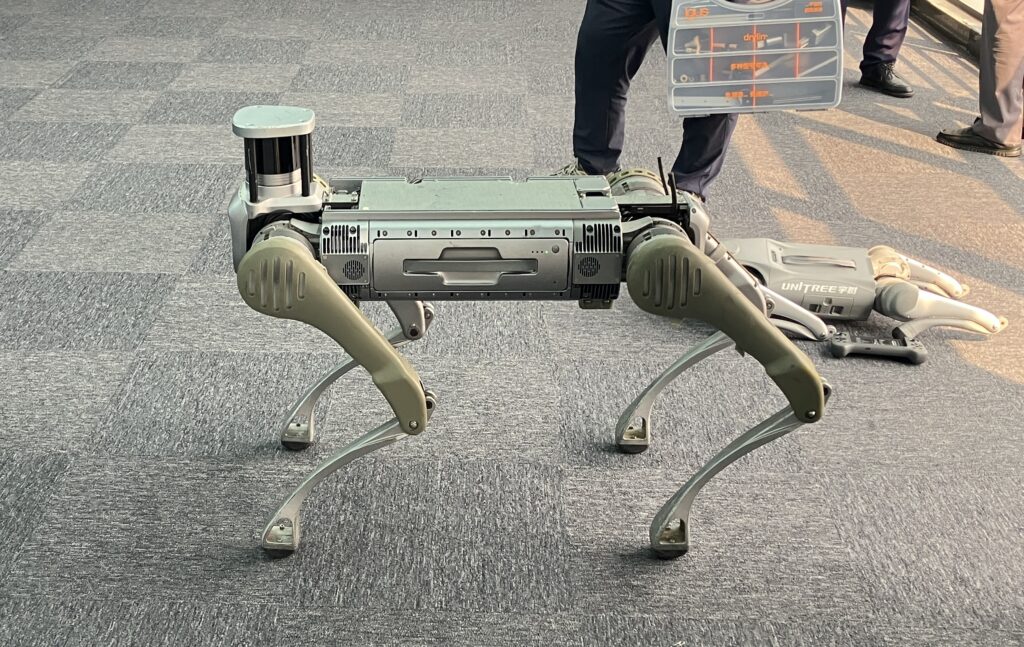
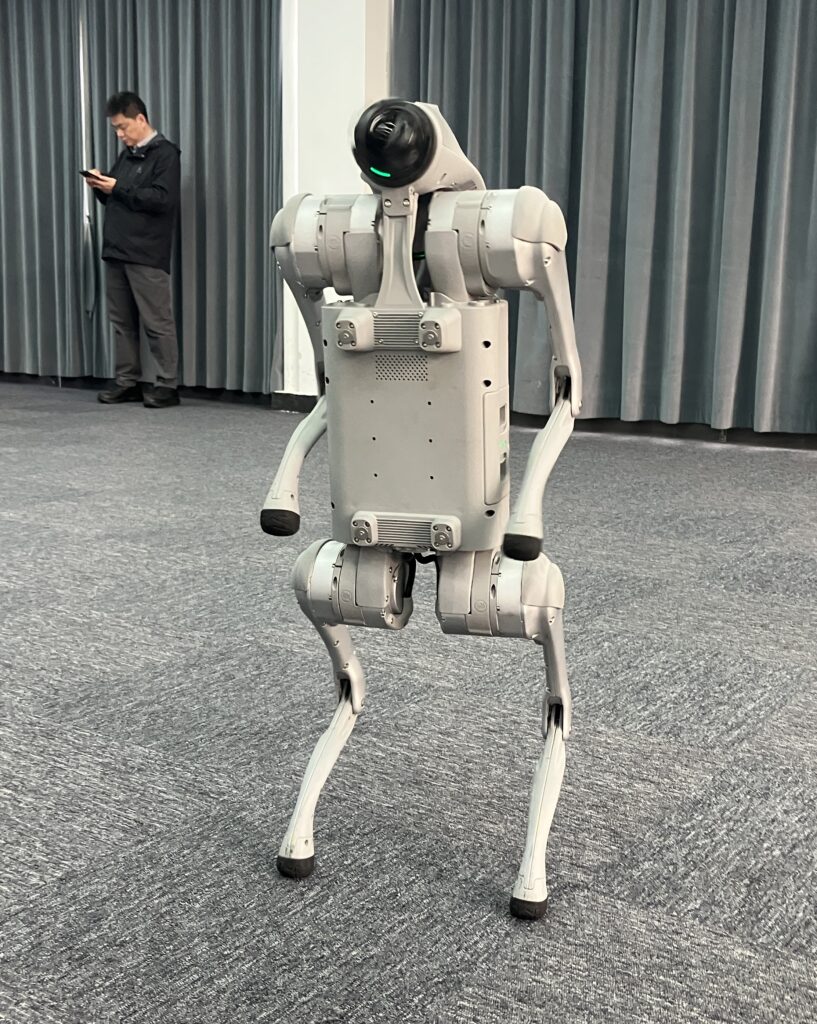
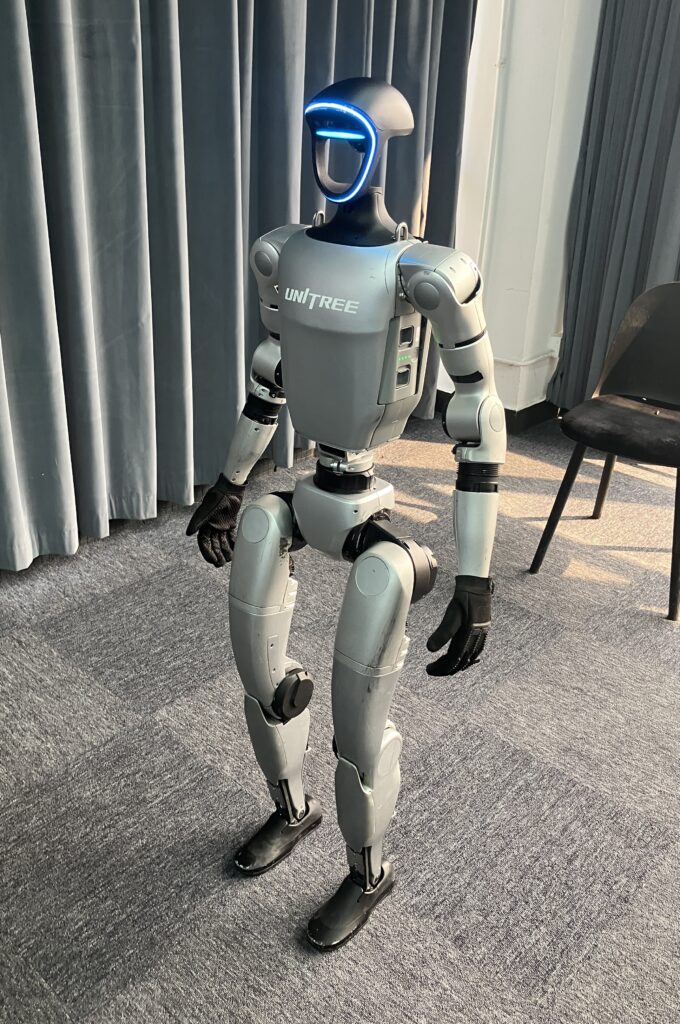
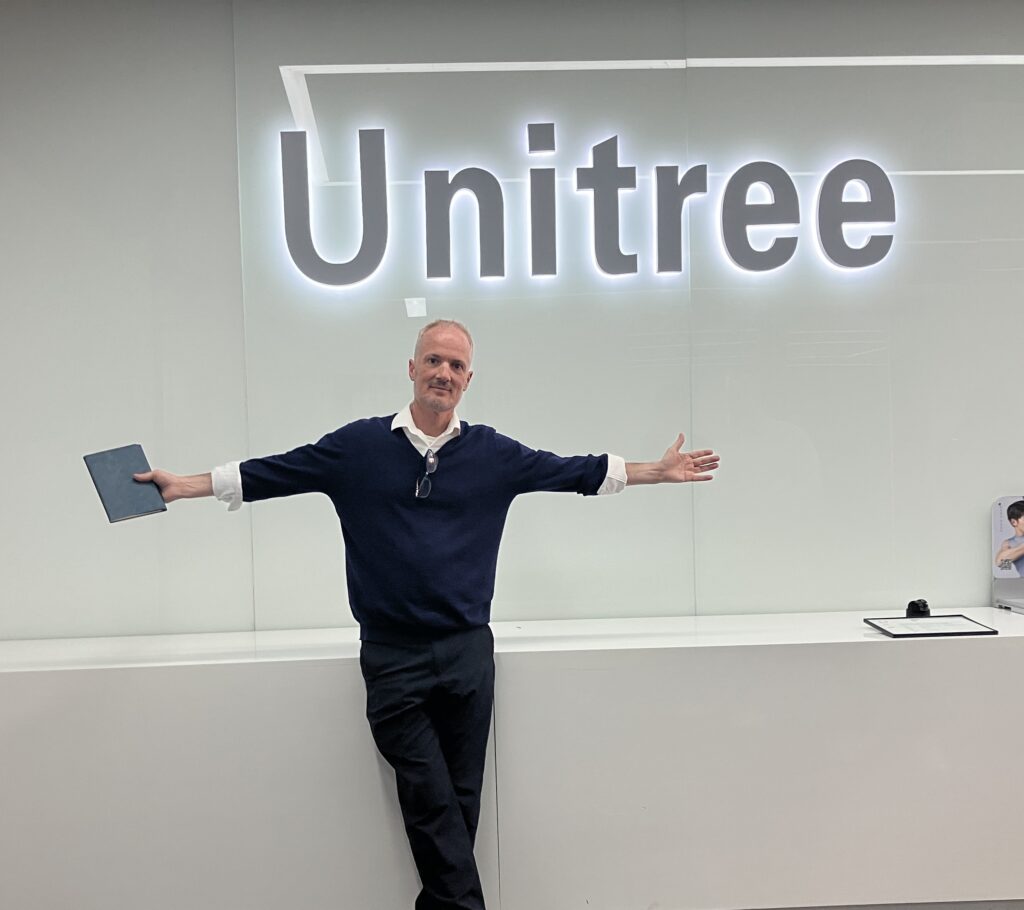
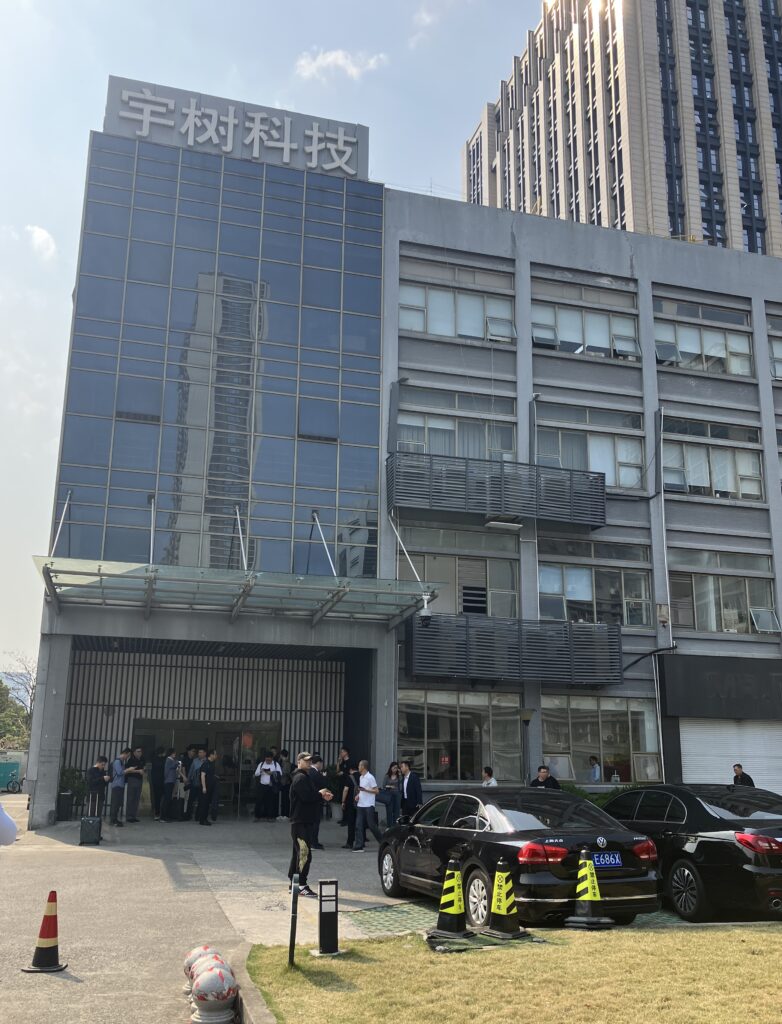
———–
Related articles:
- BYD Is Going for Global EV Leadership (1 of 2) (Tech Strategy – Daily Article)
- A Breakdown of the Verisign Business Model (2 of 2) (Tech Strategy – Daily Article)
- 3 Factors Will Determine the Future of Verisign Inc. (Tech Strategy – Podcast 191)
- A Strategy Breakdown of Arm Holdings (1 of 3) (Tech Strategy – Daily Article)
From the Concept Library, concepts for this article are:
- AI Knowledge Flywheel: Edge computed vs connected
- Economies of scale – cost, speed and flexibility
- Consumption ecosystems
From the Company Library, companies for this article are:
- Xiaomi
- Unitree Robotics
———transcription below
00:06
Welcome, welcome everybody. My name is Jeff Towson and this is the Tech Strategy Podcast from Techmoat Consulting. And the topic for today, lessons from my visits to Xiaomi and Unitree Robotics. So, I’m hanging out in a hotel room in Shanghai. It’s been kind of a whirlwind. Visit Beijing, Hangzhou, Shanghai on the way to Shenzhen, Guangzhou tonight.
00:35
Lots and lots of company visits, so lots of content on the way. But I thought I’d start with a couple that are sort of in the same category. Xiaomi, the factory where they make their EVs, spent some time there. And then Unitree Robotics, this new robotics company that’s been getting famous with all their, you know, basically they have a humanoid and a little dog robot that flip and jump and yeah, it’s been all over all the video sites.
01:03
I visited them as well. I thought I’d sort of talk about these two because they’re both in sort of the area of intelligence meets robotics, cars, really China manufacturing is what we’re talking about. So, I thought I’d talk about those. Both were pretty cool and both have cool videos and pictures so I’ll put those in the show notes on the website. Yeah, the videos are pretty great. So, I’ll put them in there. You can take a look. Anyways, that’ll be the topic for today and then
01:33
I’ll have a whole lot of content coming. I’ve just got a massive stack of notes. Tencent, Alibaba, WeChat, JD, Baidu. It’s kind of been a who’s who of cool China tech companies, plus some more traditional businesses that are sort of really good on the digital side. Anyways, ton of content coming your way. Alright, standard disclaimer, nothing in this podcast for my writing or website advice.
02:01
Our website is Investment Advice. The numbers and information for me and any guests may be incorrect. The views and opinions expressed may no longer be relevant or accurate. Overall, investing is risky. This is not investment, legal or tax advice. Do your own research. And with that, let’s get into the topic. Okay, there are a couple concepts for today. Nothing too new, but I’m going to point them out as I sort of go along. And I think the ones that are interesting here are…
02:30
the idea of a consumption ecosystem. And I’ve written about consumption ecosystems, production ecosystems, which is what most companies are actually doing. They’re not building platform business models. They don’t get to get network effects. But leading companies, as they digitize physical products or services, they can start to build digital aspects. And you can do that on the production side, and it starts to get you lots of interesting, you know, can
02:59
connect with your supply chain closer. You can share data. So, it starts to look like an ecosystem on the production side. But the more powerful one is on the consumption side when you start adding digital services to a traditional product. You work with a decent number of complementary companies to offer a more integrated, complete solution. Consumption ecosystems is kind of the go-to strategy for most businesses that are going digital.
03:29
So, talk a little bit about that, and that’s a Xiaomi story. We can also sort of talk about economies of scale in manufacturing, where usually when we talk about this, we’re talking about cost advantages. If you’re bigger and you’ve got a fixed cost that’s a percentage of your production, you can get cheaper per unit. We don’t really talk about the other side of that. Where it’s not cost, it’s about speed and flexibility.
03:58
When you’ve got scale on manufacturing, you can ramp things up faster. You can upgrade faster. You can move into new products. And we’ll talk about that with Xiaomi in regard to jumping into electric vehicles at stunning speed. And that’s really what one of my takeaways was, was the speed they moved into something new and they built out pretty big scale on the manufacturing side. Very interesting. So, there’s a kind of the two.
04:27
The other one we’ll talk about a little bit, well, I’ll talk about a little bit, is the idea of feedback loops, flywheels, with machine learning. And we’ve talked about that a lot before, but usually in the context of software, know, an LLM, and that there’s feedback between usage of the LLM and how smart it becomes. That story gets a little bit
04:55
different when we start talking about robots in the real world. Okay, there’s going to be a learning feedback loop, a flywheel, but where does it happen? Does it happen in the Edge device? Does it happen in the cloud? Is it a matter of building digital twins that then control your robots in the real world? Is it a matter of training and downloading? Is it a matter of, no, we do it in the device, like EVs, you know.
05:22
they sort of learn on their own. It’s all edge computing, but robots are not really that way. So that whole machine learning flywheel starts to look different when we go from software on your laptop to EVs going 80 miles down the highway to robots in your kitchen. Like it becomes a little bit more complicated. So, talk about that. Those are kind of the three ideas I’ve been thinking about from these two visits. Yeah, pretty cool. All right, so let’s…
05:51
I’ll just sort of take you through the trip. So basically, we get up Tuesday morning in Beijing. We’re hanging out in the Chaoyang area which is kind of my normal place. It’s up near Sanlitun and all this. Yeah, so get out there. But we’re heading down to southeastern Beijing for those familiar, the Yizhuang district. That’s where JD is. That’s where Xiaomi’s EV factory is. And actually, when you start to see things like robotaxis,
06:21
A lot of that’s down in that district. I don’t know why they’ve just sort of I guess given permission. So, there’s robo taxis down there, but you’re not going to find them in many other parts of Beijing. So anyways, we’re going down Southeast Yizhuang and that’s where Xiaomi has built their big factory for EVs. And this is the part that was, you know, it was stunning. 2021 Xiaomi
06:50
decides they’re going to start making cars. They have no experience in cars. The big boss, Lei Jun, makes the decision, 2021. 2023, they start building their factory in Yizhuang. 2024, 18 months later, it’s done and the cars start coming off the production line, March.
07:16
- So actually, it was probably late 2022 they started, but 18 months to build out. That’s unbelievable. I mean, and this is, this is a huge facility and March 2024, the cars start coming off the production line in the first year of operations, they produce and sell 250,000 vehicles and they’ve got another 150,000 orders waiting for delivery, which they say will take about six months.
07:45
Now that is, what other place in the world can you go from, let’s jump into cars, well that’s a big decision, to let’s ramp up a factory in 18 months from break ground to they’re coming off the assembly line. Now they have one model at this point. They have three different versions of it, but the SU-7 is one model. That was really stunning. And the price point for these is about,
08:13
two hundred two hundred and fifty thousand dollars so divide that by seven you know you’re getting thirty thousand dollars per car so they’re coming in right in that mid to lower range which are which is one mass market and that’s always where Xiaomi has lived you know they did this back in 2011 2012 when they jumped into smartphones they knew that they came in about half the price of an iPhone
08:43
So, they’ve always been sort of going middle of the market, maybe a little bit above. Compare that to Opo Vivo, which would go lower down in the market. That’s where they live. So, the facility’s huge. And we took a big tour of the facility. They wouldn’t let us take pictures inside the factory. They put stickers on our phone cameras so we couldn’t do it. Although I did see there, someone pointed out that one of the reporters there had taken it off or something.
09:12
So, it’s not super secure, but it’s pretty secure. I don’t have any photos inside the factory. But it’s almost all robots. It is not armies of Chinese workers in big assembly lines. They said there were about thousand workers per shift. They run two shifts per day. It was overwhelmingly robots. Some workers here and there, but not many. So, this is not Chinese manufacturing from 15 years ago.
09:41
This is pretty advanced stuff. Anyway, so we go around, we do a tour. I’m doing my normal thing where I’m peppering the people with questions. Definitely the timeline got my attention. The cars, if you haven’t seen them, I’ll put some photos in. They’re really cool. I mean, some toys are cooler than others.
10:05
This is a really cool looking car. And it looks a lot like a Porsche, and apparently, Lei Jun is a big fan of the Porsche. So, there was some design copying going on there. Different versions go up in price. They have LIDAR on the more advanced versions. That’s kind an interesting question, the idea of doing autopilot based on visual versus LIDAR. There was that Mark Rober video that went viral a couple weeks ago about
10:35
why Tesla doesn’t use lidar because Elon Musk wants cars to be able to drive just based on eyesight alone and not lidar which is decently expensive. It was kind of a bad video if you watch it. It’s kind of a hatchet job against Tesla. If I had to guess I’d say it’s politically motivated in terms of timing but who knows. Anyways the car, the SU7, super cool. The colors
11:04
bright blue you know sort of Tiffany blue, pink, purple they want it to be cool and apparently if you want black or white you have to pay extra. It’s not one of the standard colors. So, in terms of EVs on the market you got to give them credit. They’re the coolest out there and Xiaomi has always been in that space even with their phones they were just cooler. They’re better at marketing than all the rest.
11:34
Some other facts, it can go 800 kilometers on one charge and to charge it up 80 % takes 15 minutes. Okay, pretty cool. Now for those who follow this space, BYD made an announcement in the last two weeks that you can basically charge your BYD car battery in four minutes faster than filling up a tank of gas.
11:59
I don’t know anyone else who can do that because BYD, you know, they’re the battery masters of this world. There is an SUV version coming, which will be 300 plus thousand rem and B. So, divide that by seven. So, price is going up 10, 10 to 20%. They’re focused on the China market this year, 100%. There’s a six-month waiting list, even for the employees of Tesla or from Xiaomi. They’re still waiting for theirs.
12:28
Xiaomi is a public company so you can pull their financials. One of the things they’ve always said is we sell all our products for under a 5 % gross profit. They’ve always sort of been, we don’t make a lot of money on the hardware, we try to make money on the software. That’s been their mantra forever. Now, I’ve never actually seen them making a lot of money on the software, but if you check their hardware prices, they are always under 5 % and
12:58
most of their history they were under two or three percent so I assume they’re doing the same thing for the cars at this point. We go through the batteries you know they’re not really a manufacturing company so the batteries are coming from BYD, CATL they’re not doing that in-house. The part that gets interesting with them is when you start talking about the operating system and they have their hyper OS
13:27
which is the operating system that runs the car. And they’re playing off the intersection between the car, the home products, smart home, and smartphone. And their new ecosystem is described as car, home, person. So, the devices in all of those three things interact. And this is where you get to the idea of a consumption ecosystem, because they are not a manufacturing giant.
13:56
BYD is a manufacturing giant. They are not an AI giant yet. Tesla is an AI giant. You can see sort of three business models within EVs. The pure manufacturer and powerhouse, that’s BYD. The real-world AI company, that’s Tesla. And then you can see Xiaomi is a pretty good example of a consumption ecosystem business model. And the number I always look for Xiaomi is
14:27
how many devices does their average customer have connected that are Xiaomi devices? And one of the facts they told us was 70 million people have five Xiaomi products. So, they’re cross-selling devices and then they’re integrating the devices as much as possible. So, you sit down in the car, you can put your phone on the dashboard, it automatically charges. That’s pretty standard in Chinese EVs these days.
14:57
You can project, can basically turn the screens in the car into your smartphone screen. So, it can just shoot it up on the screen like, you know, Tony Stark does in the movies. You can start to give it voice commands as you come home, arriving home. And suddenly all the settings in your house go on. The curtains open, the lights go on, the air conditioner goes on. And they’ve been doing a lot of sales in air conditioners recently. They said their numbers are pretty good. I’m going to pull them for 2024.
15:28
Revenue up and I asked kind of where your sales coming from and they basically said air conditioners and smartphones but it’s going to be one of their best years So you can see they’re starting to integrate the home the car and then of course the entertainment system is all integrated That’s where they’re focused today. They’re a consumption ecosystem Where are they going? They’re going into AI, right? They’re not you know
15:57
All of these companies are kind of converging, BYD, Tesla, know, Xiaomi. But Xiaomi is obviously very, very new to the game. So, you got to start with what you got. But it looks to me like they’re going after the Tesla model as fast as they can. So, they’ve got their pilot autonomous vehicle thing coming online. I couldn’t get too many details about what they’re doing in terms of…
16:26
the architecture. They’ll tell you a little bit, we’ve got Nvidia chips going in, we’re building auto drive, okay. But that’s kind of where they’re going. oh and of course if you want to jump in the car, it goes zero to 60 in like one second, but they all say that. I’m not really sure what the value of how fast you can go to 100 kilometers per hour is, but everyone always gives you those sorts of statistics.
16:55
Anyway, so we go through the factory. It’s pretty amazing. Yeah, that was kind of my biggest takeaway was really, let’s get to sort of lessons here. was number one is the consumption ecosystem play. Car, person, home. That’s actually very similar to what Xiaomi has been, or not Xiaomi, Huawei has been saying for years, you know, one plus three plus seven. Was it seven?
17:24
No, I got that wrong. One plus seven plus N. That’s the ecosystem for consumers. Number one is your smartphone. That’s what Xiaomi is calling person. Then you get to seven main devices that connect to your smartphone. That’s going to be car watch home airbud. I forget a couple others and then None plus seven plus and the end stands for IOT devices everywhere.
17:54
So, you’re going to connect to everything and they’re creating products for all of that. Xiaomi doesn’t go that far because they’re not an infrastructure company so they can’t do the end. So, they’re kind of doing the one plus seven but they call it car person home. OK so consumption ecosystem. The question is how strong that is really. You know when you start to do ecosystems like Word Excel PowerPoint. You can package them.
18:23
So, you do bundle, that’s powerful. You do cross-selling, that’s powerful. And they also integrate with each other so they all work better together. Adobe is a better version of that. All their products work better, Lightroom, Premier. Does car home person really integrate? Or can you just sort of jump from company to company for that? So far I think they’re not that well integrated. I think you can cross-sell and I think you can bundle. I don’t necessarily see them integrating.
18:54
My standard rule is I buy an iPhone because I have to. I don’t like it. I think it sucks. Everything else, that smartphone, I buy pretty much Huawei products because I think they’re the highest quality hardware. So, watch earbuds, a couple Xiaomi in the home, but I sort of mix and match. So, you kind of got to see if you’re a believer in the ecosystem. That’s lesson number one. Lesson number two, I already mentioned, which is
19:22
manufacturing build out, manufacturing scale and speed as a capability that a company can tap into. And it’s not just about being cheap, it’s the speed and the flexibility. So, if they can jump into cars this quickly, if they can deploy a massive factory this quickly, it’s not a onetime thing. You do that all the time.
19:49
keep releasing new types of cars because your factory is flexible. You keep upgrading your factory. You keep upgrading your car. it’s sort of speed is as important as the cost thing. So, China has that and you would expect this speed that we’re seeing from Xiaomi. That’s going to keep happening. They’re going to have new factories. Their existing factories are going to change quickly. Their products are going to change quickly. They’re going to upgrade quickly.
20:19
Western companies like Tesla, it’s harder for them to do that usually. Usually, we’ve seen this dynamic for 30 years. Chinese companies are usually cheap and flexible. Japanese manufacturers, they have a good price point, but they get there by sort of really deeply deployed automation.
20:45
which makes it harder to change. If you’re going to retool an entire automated factory floor in Japan, it takes a lot of time. And this is kind of, for those of you who want to know the history of China, one of the reasons BYD broke out of nowhere in 1995, jumped into battery production for laptops, for smartphones, and took down all the Japanese manufacturers who had previously dominated that sector.
21:14
It was a combination of cost and flexibility. They could move their factories around very, really quickly and switch from lithium to nickel like it was nothing. Japanese companies couldn’t do that. And that’s really how BYD took the market. 1995, they got into it. By 2005, they were the largest manufacturer of batteries in the world. 50 % of all the laptops and smartphones in the world had BYD batteries. It was the
21:42
sort of cost-plus flexibility and speed. Anyway, so that’s kind of lesson number two is think about this as a capability and how good Chinese companies are at leveraging this into business. And I think that’s the weakness of the US and definitely of Europe. right, lesson number three for Xiaomi, last one, then I’ll move on to Unitree. High performance management.
22:07
My little digital strategy framework, I always talk about Steve Jobs, Elon Musk, Warren Buffett. Warren Buffett symbolizes build your moat. Elon Musk symbolizes operating performance and speed. And Steve Jobs symbolizes product launch, product market fit, all of that. When you look at Xiaomi, they have one of the best tech teams on the planet. mean, they’re really, really good at it, but…
22:36
Is this a Steve Jobs story or is this an Elon Musk story? Well, we can definitely see the Elon Musk story. They can build factories like it’s nothing. They launch new products every couple of weeks. If you go into Xiaomi store, there are new products every single, not every week, but every month for sure. So, they’re always sort of coming up with new stuff to keep people excited and thrilled. So, they’ve got the Elon Musk operating speed.
23:05
But the EV story to me is the Steve Jobs story. They have no history of being in cars. Within three years, they’re a major player. So, this idea of we’re going to jump into a new product, that’s a different skill set. Apple is not very good at that. And so, when you jump into entirely new products, you sort of ask yourself two questions.
23:33
Is this a small bet or a big bet? Small bets are Apple going into AirPods. Xiaomi going into cars is a major bet. This is big bet. This is like Facebook going into VR, which they fumbled. It didn’t work. This is Apple trying to go into cars, 10 years, $10 billion of spending, couldn’t deliver a product. Can you make a big bet?
24:02
versus an ancillary product or service. Xiaomi is good at making big bets. the checks they’re writing, there’s a reason most management teams, you don’t want them to make big bets because you don’t want them to risk that much. These are huge expenditures. The Xiaomi team can make big bets and pull it off. Most companies can’t. So, I always look small bet versus big bet. And then I always look at
24:31
What is the distance from this business to your core today? Apple going from smartphones to ear pods, it’s a small bet and it’s a half step from where they are. It’s not very far. That’s like Coca-Cola going into water. It’s a half step. It’s an ancillary product.
24:55
these distant bets, usually there’s a great BCG study, I don’t 20 years ago, basically showing that the probability of failure goes up dramatically as you move from your core capabilities to more and more distant products. Okay, going from smartphones to cars is a distant jump. It’s a whole new world. So, Xiaomi, this is why think Xiaomi is the Steve Jobs story.
25:23
They made a major big bet in a business that is very far from what they do. The probability of failure was high, which is why Apple failed. They pulled it off. You know, if you’re, if you’re investing in a company and you hear a team doing this, we’re making a big bet in something very distant. It’s generally not a good thing. Like you don’t like to see companies doing this because the likelihood of failure is quite high. And if it’s a big bet, that hurts.
25:53
So, when I was looking for sort of how you assess management performance and you look at Xiaomi, that’s, they are very comfortable making big bets very distant from their core business and they seem to pull it off. You know, keep in mind, and there’s 20 years of this, Lei Jun and his team, they were at Kingsoft. They were doing software, Microsoft Word type stuff. They were doing advertising, gaming.
26:17
They took a jump into smartphones. Nobody on that team had any experience in anything hardware ish. They were software people. They jumped into hardware with smartphones, smart home devices, all of that. Now maybe that wasn’t a great idea because those aren’t really great businesses. Well, this is another major jump out of smartphones, smart homes, into cars. They’re doing in manual, you know. Anyways, that was kind of my other takeaway. This is a high-performance management team.
26:48
And to pat myself on the back a little bit. I basically said this three years ago, like Xiaomi made an announcement that they’re going into cars and it was kind of a weird thing. And I was like, you know, if anyone’s going to surprise us, I think it’s this team. Like I called them sort of the black horse. You know, they were just this other player. Nobody was talking about. I’m like, look, if anyone’s going to jump in here and shock the world, it’s going to be these team. And then they kind of did it. And we’ll see. This is just step one.
27:17
We’ll see what happens in step two, step three, step four. Anyways, those are sort of my three lessons. Consumption ecosystem, high performance management, Steve Jobs versus the Elon idea, and then manufacturing scale as a capability for both cost and speed and flexibility. Okay, so that’s Xiaomi. Then we flew down to Hangzhou. Hangzhou is a great city. Really, I can remember 2007, 2008. Hangzhou was this sort of
27:47
Not sleepy town, but you know, it was sort of a tourist city. had the West Lake. It wasn’t that developed. It wasn’t really somewhere you went outside of tourism. And back then you took the train from Shanghai and it was about three to four hours. Well, now it’s, you know, I think it’s a first-tier city now. You know, the first-tier cities of China, Beijing, Shanghai, Hangzhou, Shenzhen, and maybe Guangzhou. And I mean, even Shanghai, if you’re talking about the tech world,
28:17
You don’t really talk about Shanghai very much. It’s usually Beijing, Shenzhen, Hangzhou. That’s the story. then Singapore, that’s kind of the tech world. So, you know, it’s pretty fantastic now. First of all, the tourist areas, the West Lake, is absolutely beautiful. It’s all been redone. The walk around the lake is really stunning.
28:41
One, it’s pretty because it’s a lake, it’s got mountains ringing in it, but two, the development is just beautiful. But then they have all these new districts, which are all tech companies, Alibaba’s everywhere, multiple campuses, including the new one. Ant is there, Cainiao is there, Unitree is there, although their building is really funny. It’s just a nondescript office building.
29:10
that looks like it was built in 2003. It is not even a nice building. And you sort of go in and you’re like, this is the building? Really? This looks like somewhere, you know, they’re fixing tires or something. It’s just, you know, your standard office factory building from like 1995. It’s got a gate in there, but as soon as you go in, you see things in the back in the parking lot, like employees walking around the little robot dog.
29:39
doing little training stuff. you ever see the videos of Unitree and I’ll put some links with their robots doing stuff, look behind the robot and you’ll see they’re kind of in this regular old parking lot. That’s the Unitree headquarters. So that was kind of interesting. And then you go in and the showroom is, it’s just an empty room. There’s no front desk. It’s pretty, I don’t want to say primitive, but yeah, kind of. So, I mean, I used to have an office in Shanghai.
30:09
my office was nicer than the unitree office by a lot. kind of interesting that that contrast. Anyway, so bouncing around Hangzhou other companies there, a lot of the express delivery companies, SF Express, ZTO, STO, they are based in Hangzhou. I think they just grew up around Alibaba basically. And then of course, famously DeepSeek is in Hangzhou and we did go to the DeepSeek office.
30:40
You cannot get in. I tried to contact people. I got nothing. So, we did take photos in the lobby. So, I’ll post those. And it’s another… Now that building is actually kind of decent. It’s a nice office building. And they’re just a random business that’s on the fifth floor. So, you wouldn’t know this is like one of the most famous companies in the world now. But at least it’s a grade A office building. You know, the unitree office is like a grade B to grade C.
31:10
office. It’s probably closer to C. Anyway, so we go out there really cool. There’s not as much of a business story to talk about with this company because they are really early stage. They’re basically building products. And when you start to talk to them about the business model and the business cases, they’re not there yet for the most part. So, it’s mostly a sort of earlier stage product story and they basically have
31:40
three products at this point. So, they start with the dog, which they have been building since 2013. And back then the founder, was called the X dog. And I have pictures of the early version. They have them all sort of laid out one by one, starting in 2012 to today, there must’ve been nine or 10 of them in a row. And the first one looks like something you built in a garage, but you the X dog,
32:10
was what the founder kind of did and then it wasn’t really a company yet and then the founder joined DJI for one to two years, then jumped out 2016 and the Leica Go was the next robot. There was the Alien Go 2019. Basically, a basic dog where they at certain point added cameras on the front so we could see. At a certain point they started to put LIDAR on the top. And then around 2020-ish,
32:41
they started to make it more programmable. Up until then, was pretty much, you program what the dog could do. It had a series of things you could do. You control it with a remote controller. At a certain point, 2020 or so, they started to give other people basically a software development stack toolkit. And then other programmers could buy the dog and start to program things it could do, which are then downloaded into the dog.
33:09
You know, so suddenly it can do a backflip. Suddenly it can do Kung Fu. So, when you look at the videos of Unitree, those are all programs that have been developed mostly by Unitree that can be downloaded. And they call it sort of SIM to training SIM and then you download it into the dog. And this will be a sort of a key point for thinking about Unitree. All right, 2021, they start to get well known with the Go One. So.
33:38
It’s a good-looking dog. It can run around. They start to do two versions of the dog. The small one, which is kind of a toy, and then a bigger one that can carry weight. And it can walk on peg legs or they start to put wheels. And this is where you start to see the video where this dog is zipping down the street. And that’s kind of lesson number one. The thing that I think has made them famous and that got my attention,
34:06
was the agility of the robots. It moves really fast. It goes down the street. It does a flip. It does a back flip. It does a side flip. It can go across the river. If you put wheels on it, it really moves. But even if you don’t put the wheels, you just put the legs, it can run quite fast.
34:27
up the mountain, down the slope, it can go upstairs, it can go up on its hind legs and walk around like a little person, it can go up on its front legs and do handstands, it can go up on one wheel and sort of balance. And the flexibility and agility is where this looks like a person, in fact, not only does it look like it looks like it can move like a human can’t. So, the sort of capability jump.
34:56
in terms of agility and dexterity. The small dog zippers are on. You move up to the larger dog. This is one where they do these in sort of pairs. They have a smaller version. That’s your entry level version. The small dog’s about $1,500 for the basic model. If you want one that you can program, it’s about 8,000 USD. That steps you up to the larger version, which is the B2.
35:24
The go-to is their current version of the small dog. The big dog is the B2. That’s the one where I stood on top of it and it lifted me up like it was nothing. It can carry about 125 kilograms. So that becomes your workhorse. That’s the one you can use in your factory to move things. It’s got
35:45
cameras in the front plus lidar, you can put a robot arm on the back so it can do things, it can carry rear weight. That’s the one if you see videos where people just sit on the back and ride it around like a little car, that’s the B2.
36:00
Use cases for the most part for these dogs are inspection. Now those are the ones they tell you about. What’s the use case? Inspection. It can zip around gas stations, power plants, and it can look at things and it’s got good cameras. And you can put different types of cameras on the front, infrared, all that. So, the use cases are kind of inspection, things like that. Now, are there other security-related use cases? I don’t know.
36:29
They didn’t say anything like that, but it kind of looks like maybe. Drones went from toys to the war in Russia and Ukraine pretty quickly. But I don’t know what these robots are being used for. So anyways, we talked about use cases inspection. In terms of its capabilities, OK, you’re programming things on the simulator.
36:57
testing them there, training them there, and then downloading them in the dog. And it’s a combination of those pre-programmed abilities plus the remote control, plus it has some in-device avoidance ability. There’s literally a little light on the front, and there’s a red light or a green light. And when the green lights on, it’s doing obstacle avoidance. So, it will be doing its routine, whatever its programmed, you give it do-a-flip command.
37:25
But if I walk up to it, it will switch and back away from me. So, you can see sort of the breakdown between who’s doing the programming. The company, Unitree does a lot, but also lots of basically developers around the world are programming things these robots can do. Where is the programming happening? It’s mostly happening on software and simulations and then downloaded. But there’s some degree of sort of edge computing where it can do obstacle avoidance and stuff like that.
37:56
So, I ask questions like, okay, so that’s sort of the two robots. And then the next one is the humanoid, which is the H1. Pretty cool. It’s short. It’s got some basic, you know, it comes up to about my shoulders. It walks around. If you grab it and try and push it over, it’s very hard to push it over. It will stumble and catch itself and stay upright. You can push it sideways. You can push it forward. It’ll, you can literally drag it by.
38:25
handle and it you probably could make it fall over but it’s pretty hard use case for that one unclear at this point people are playing with it I asked them like what’s your coolest use case they said MIT is playing with these and they’re teaching it how to cook okay
38:47
I asked for what the coolest use case was for the dog and they said it was people had trained it to help blind people navigate the streets. You can just hang, you know, have a leash and it’ll take you around. You just follow it. That’s interesting. A battery life is about four hours for the dog, for the B2. For the humanoid, it’s one to two hours. And when they talk about what they’re working on, a lot of the discussion turns into it about weight. We got to make it lighter and battery.
39:17
And then it’s like who’s doing the programming. So, you buy one for your factory. You basically scan in the entire environment. Then you give it routes to run around and do inspection. You combine that with its sort of onboard obstacle avoidance. And it walks around. Anyways, that’s kind of where it is. The humanoid robot, $16,000 for the non-programmable one.
39:45
They’re hunting all over, they’re selling in China. Obviously, they’re starting to sell in the USA, Europe. And you would kind of look for developer adoption. You want to kind of become the standard programming platform for robots, right? If you’re a business, how do you make money doing this? Well, you sell the robots, and then you want to become the platform that everyone is using to program their robots. So, it’s a standardization network effect play.
40:15
plus, some economies of scale and manufacturing. And plus, it’s pretty cool. So that’s kind of where we are. The lessons I had for that one, interesting. The first one I’ve already mentioned, is lesson number one, I have three for unitree. The big jump in agility and dexterity. The speed, the ability to balance.
40:44
it’s clear you can kind of see the future for the first time. And these are early days. So that’s number one. The limited use cases for them today raises the question, is the future what Unitree is doing, which is we’re going to build standardized robots, a dog model, a humanoid model, and then people are going to
41:11
write lots of code and routines for it. And we’re going to go for a standardized robot with a big programmer ecosystem. So that’s the MIT cooking thing. Or is the future not standardized robots? We’re going to have specialized robots for different use cases.
41:36
the robot in the kitchen that’s cooking is going to look very, different than the robot that’s leading a blind person down the street. There’s a really interesting business question there. Standardized robots that you get to scale and then it’s about the programmer ecosystem, or is it lots and lots of niche specialized robots where you specialize in both the hardware and the software at the same time?
42:04
That to me is kind of an interesting question. It is clear that Unitree is betting on the first. But you can go over China and you can see all sorts of little robots. Different one for cutting grass. Different one for inspection. Different one. What if you’re inspecting power lines? You know, what if we have little robots that run along the train tracks and just inspect the train tracks at high speed? What about security guards?
42:32
So, is the hardware plus software going to become specialized or is it going to be a standard hardware and then the developer ecosystem? I think that’s an interesting question and that gets you back to economies of scale, but it also gets you back to Xiaomi. know, Xiaomi was very good at creating an entirely new factory very, very quickly. Well, maybe what we’re going to see out of China is a whole lot of factories spinning up.
43:01
very, very quickly for specialized use cases with specialized hardware. Well, that’s interesting. In the US, it looks like Tesla’s not doing that. It looks like they’re going to build the Colossus, a standardized robot that has lots of use cases. Well, China might be a counter strategy. We can spin up a factory in 12 months for any little niche robot we can think of. So, there’s a cool business question there. That’s kind of lesson number two.
43:31
Lesson number three, last one.
43:34
Where is the?
43:37
sort of feedback loop flywheel for machine learning for these robots. Now, if we’re doing machine learning on our laptop, there’s a nice direct feedback loop from I’m putting chat and prompt queries, it’s generating, the model’s getting smarter. It’s all virtual. There’s feedback loop before in use cases, usage, and.
44:04
the foundation model intelligence and rate of development. Okay. What about Tesla? Well, Tesla is mostly an edge computing situation because, you know, basically the robot has to make decisions very, very quickly. So, you can’t download a lot of programs into a Tesla for what to do in every situation. And even the connectivity between the Tesla and let’s say the cloud, the latency is a problem.
44:34
So, you’re doing a lot of reinforcement learning, that machine learning flywheel, in the car itself. Okay, and then we’ve got sort of two other cases in between there. One would be what we see at Unitree today, which is we’re mostly doing the learning in simulation models and we’re downloading into the robot what to do in different situations. And then there’s some degree of ability within the robot.
45:04
but most of the training is done in simulators and download it. Okay. And then the other use case is, you know, the 5G connectivity thing where whatever device you’re doing is in rapid communication with the cloud. And you don’t need the latency to be hyper fast like a car going down the road, but you can have sort of rapid connectivity between the device and the cloud and
45:34
Machine learning is probably in the cloud mostly. So, there’s three or four use cases there that are really kind of interesting. So, when you talk about embodied intelligence, this idea of physical devices in the world that are increasingly intelligent, well, where does the intelligence lie? Where’s the feedback loop? One of the other companies we talked to was in the gaming world.
46:02
They had an interesting thing because gaming companies are very good at the gaming engines, basically building virtual worlds, which are basically digital twins. And they were talking about how they’re working in robotics a little bit. And what they’re doing is they’re sort of tying the virtual world to the real world. So, if you’re doing a mining project, you have lots of robots going around, or let’s say construction.
46:28
Lots of robots going around, backhoes, tractors, and whatever. But then they’ve paired that world with a digital twin, which operates in the virtual world. And everything that happens in the virtual world, you move the tractors around, that is transmitted as orders down to the real world to tell the tractors where to go. But then the data also comes from the sensors on the tractors back up into the virtual world. So, we’ve sort of got this digital twin model.
46:58
that’s operating in real-time connectivity between a construction site and a digital twin, which is really a gaming engine. That’s an interesting model as well, especially when you have a controlled environment like a construction site or a mining facility or a port, and you can replicate the whole environment and do that. So, there’s a couple models in there in terms of embodied intelligence. How does that play out?
47:28
That was my other big question for Unitree. And right now, they’re clearly just doing it in simulations and downloading it. And I don’t even think there’s any real real-time connectivity happening. anyways, that’s kind of my takeaways from that early-stage company. But I think it pairs in an interesting way with the Xiaomi case. But yeah, those are, I’ll put my sort of key takeaways here in the notes. But consumption ecosystem.
47:58
What does it mean to be high performance management? The Steve Jobs things, rapid manufacturing build out as a China capability, which is a big deal given the rise of robotics in AV, EV, unitary, the big jump in ability, dexterity, agility. This idea of standardized robots with, know, software use cases versus specialized robots. And then this sort of.
48:26
Where does the intelligence lie? Where is the flywheel in embodied intelligence? Anyways, that is the content for today. How am I doing on time? Yeah, 40 minutes, not too bad for me. So, as I’m packing up, I’m checking out of the hotel in about an hour, heading off to the airport. It’s going to be great. Some really cool companies, Tencent, WeRide, Huawei.
48:53
down in Shenzhen. Guangzhou, which I don’t usually spend a lot of time in Guangzhou, but WeRide is there, which is they do robo vans, robo taxis, robo sweepers, so they’re definitely sort of all about autonomous driving, and they do the software to the hardware. Different than, say, Horizon Robotics, which I talked about last week. And then, so Guangzhou interesting. WeChat is actually based in Guangzhou.
49:22
It’s not in Shenzhen with the Tencent headquarters. It’s up there during chat with them. Huawei, I’m still trying to meet DJI and BYD. Like I’ve been shot down by these two companies so many times. It’s almost humiliating, but I’ve never really had much interaction with them a little bit, but not much. Anyways, they’re both based in Shenzhen. So, I don’t know that’s going to happen. Probably not this trip.
49:51
Anyways, that is it for me. I hope this is helpful. It’s been, man, things are moving in China. I can remember back 2019, 2020, you know, the international world, especially the U.S., kind of was starting to write off China in terms of the tech world. It was seen as very political. There was the tech crackdown. was, you know, everyone was kind of, ah, it’s uninvestable. It’s not a big deal. Everyone was kind of turning away from China.
50:20
in terms of tech outside of China. And I’ve been on the ground since 2007. And I was like, man, you got to come on the ground and take a look around. It’s the vibrancy, the enthusiasm, the rate of innovation. It is just moving fast. I think people have kind of in the last year come back around, know, deep seek.
50:46
Alibaba cloud, Tencent cloud, Baidu cloud, the robots, the EVs, man it’s moving. And you really get that when you’re on the ground, you sort of feel it. I was at the JD headquarters; I’ll talk about them. Their headquarters is massive now in southeastern Beijing. It’s three to four times bigger than it was three to four years ago. It used to be one big building which had like 10,000 people.
51:15
They’ve got four buildings now and they’re building a massive campus. I took pictures of the models. The campus they’re building is absolutely huge. I can remember talking about how JD had 10 to 11,000 people in 2010 and back in 2017 they had jumped to 150,000 people. And I remember saying this, that’s a huge amount of hiring. They’re at 500 plus thousand people now.
51:44
The rate of build out of these companies, it’s everybody’s got their pedal to the floor basically. And pretty much every tech company we talk to is international focus now. A lot because the economy here has been slowing pretty significantly actually. So, everyone is international focus. It is core strategy for almost all of these companies. We’re going to Southeast Asia, all of them. What they really want is Europe.
52:13
which is obviously a much bigger dollar market and the US is too unpredictable. So, every company we’re talking to, we’re going international aggressively. So anyways, the story’s pretty great right now and it’s going to get more exciting. Anyways, that is it for me. I hope everyone is doing well. I know for subscribers; I owe you some articles. I’ve been on the road. Like we leave at 8 a.m. in the morning. We don’t get back till 10 p.m. at night. So, I’ve been sort of out of pocket for the last nine, 10 days.
52:43
So, but don’t worry I’m going to hit you with more content than you want. You know you’ll get annoyed at all these emails coming from 17 companies we visited. So, I’m a little bit behind this week. Sorry about that but I’m going to. Yeah it’s on the way. That’s it for me. Have a great week and I will talk to you in a couple of days. I’ll be out of here probably Wednesday Tuesday. Cool. Take care. Bye bye.
——
I am a consultant and keynote speaker on how to accelerate growth with improving customer experiences (CX) and digital moats.
I am a partner at TechMoat Consulting, a consulting firm specialized in how to increase growth with improved customer experiences (CX), personalization and other types of customer value. Get in touch here.
I am also author of the Moats and Marathons book series, a framework for building and measuring competitive advantages in digital businesses.
Note: This content (articles, podcasts, website info) is not investment advice. The information and opinions from me and any guests may be incorrect. The numbers and information may be wrong. The views expressed may no longer be relevant or accurate. Investing is risky. Do your own research.
